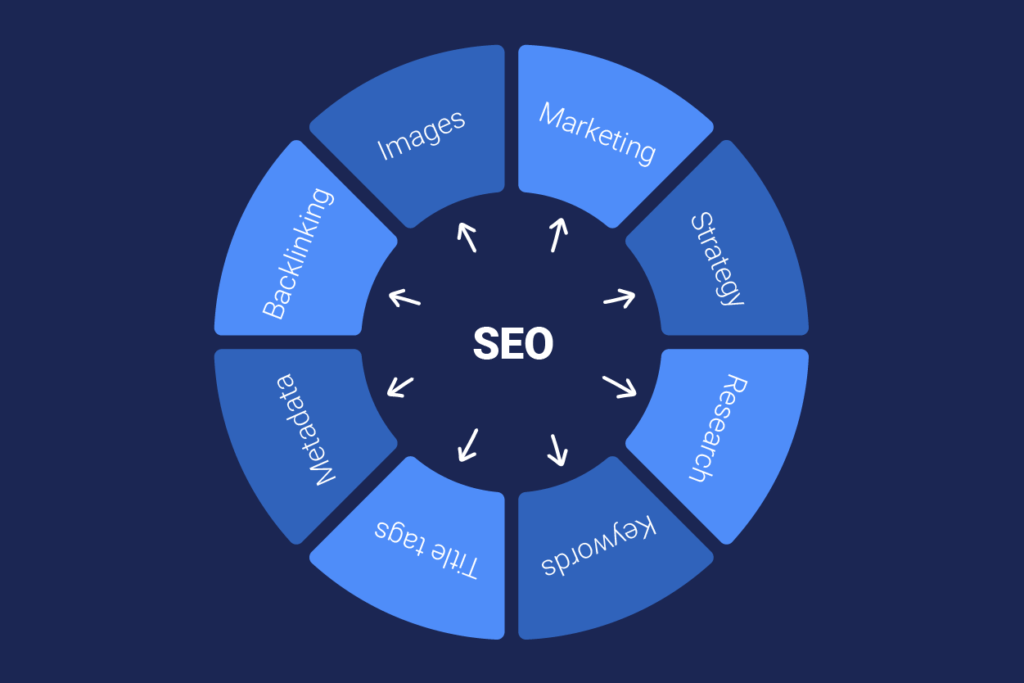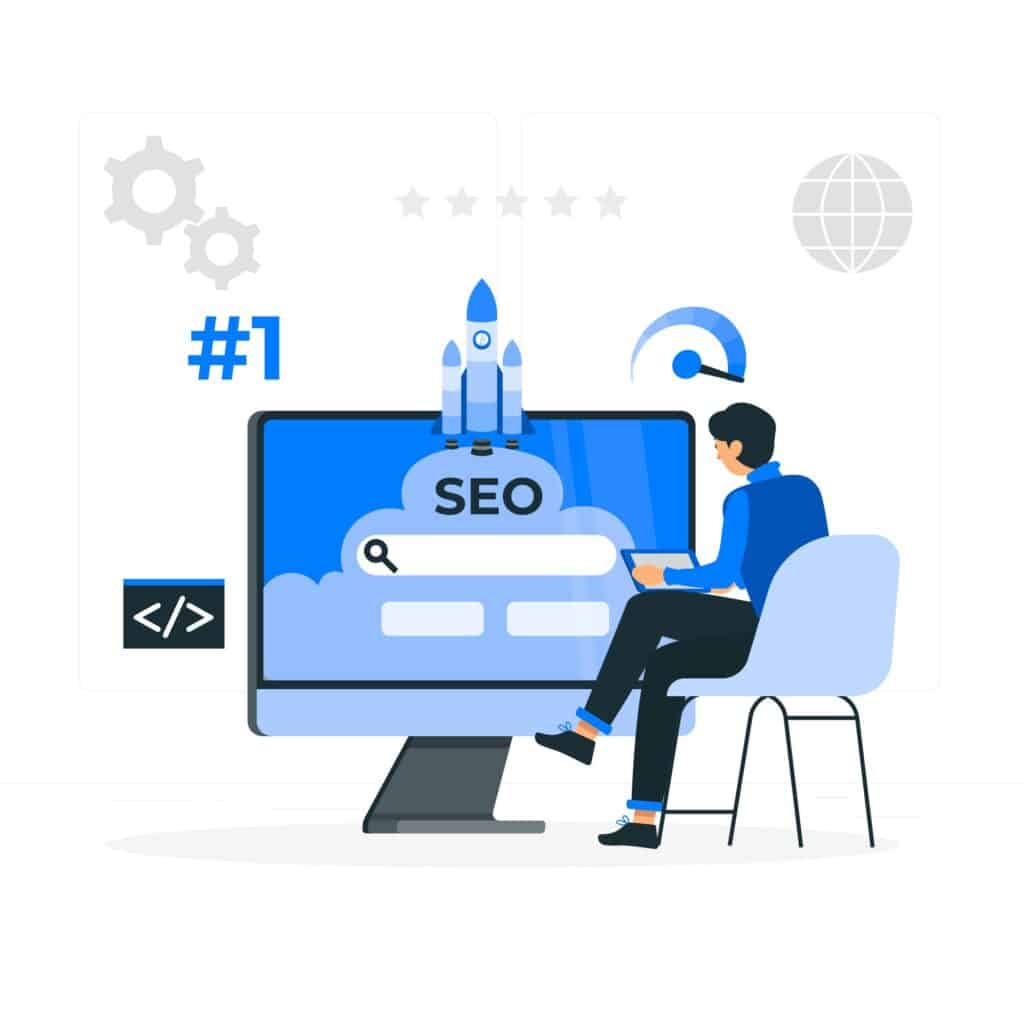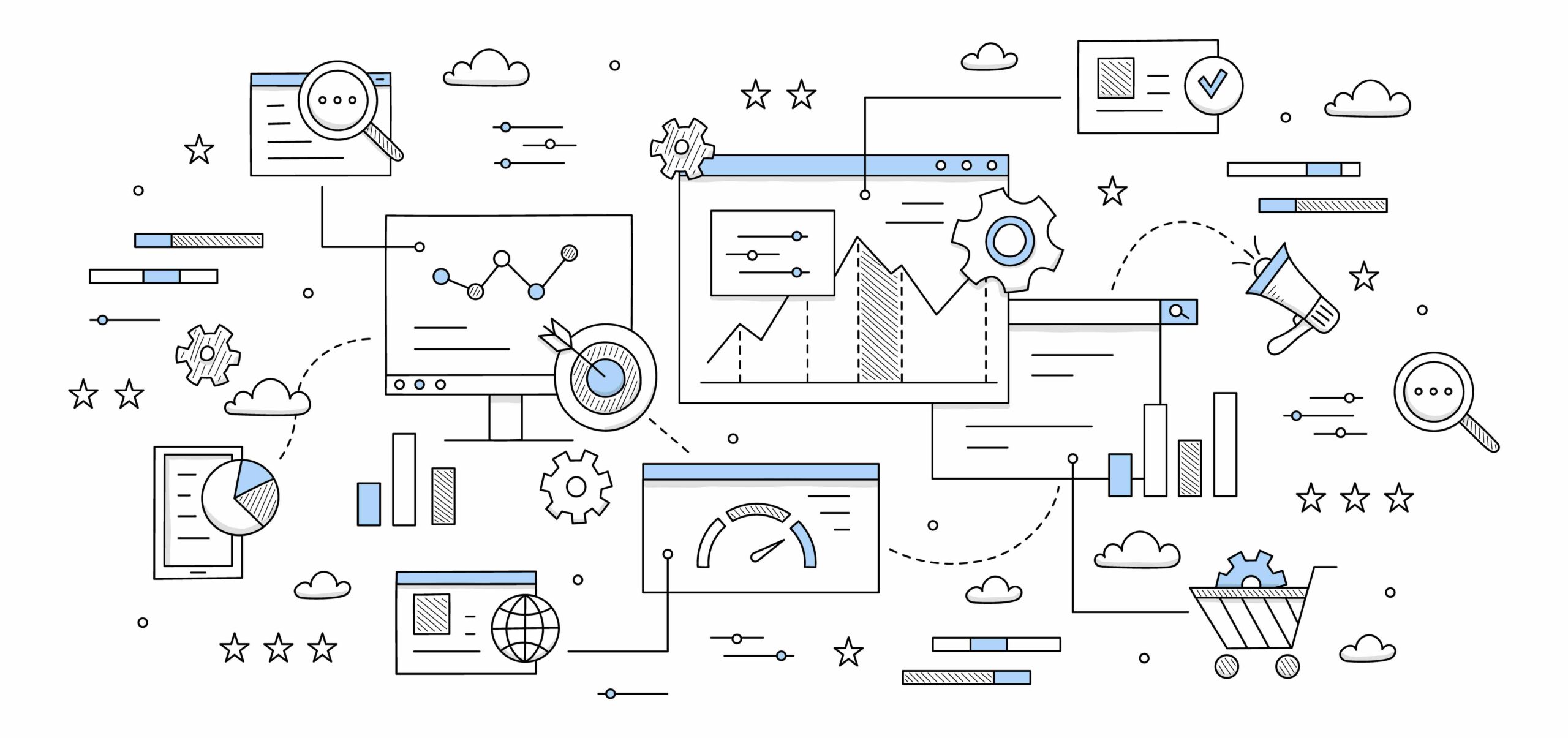Table of Contents
What Is On Page SEO?
On page SEO, an essential part of search engine optimization (SEO), focuses on optimizing specific elements of a webpage to improve its chances of ranking higher on search engines. By enhancing individual pieces of content, titles, meta descriptions, and other page elements, websites can create a more user-friendly experience, which is beneficial both for users and search engines. Factors like high-quality content, keywords, and internal links play a pivotal role in on-page SEO.
What’s the Difference Between On Page SEO and Off Page SEO?
While both are crucial components of SEO, they target different areas:
- On Page SEO: Involves optimizing website elements present on your page, including content, titles, meta descriptions, internal links, and more. It ensures that the webpage’s architecture is user-friendly and its content is relevant and easily understood by search engines and users.
- Off Page SEO: Focuses on external factors that impact your site’s reputation and authority. This includes practices like earning backlinks from authoritative websites, social media marketing, and other external signals.
Why Is On Page SEO Important?
- User Experience: On page SEO improves user experience by offering users relevant content and a site that’s easy to navigate on any device, whether it’s a mobile device or a browser on desktop devices.
- Increased Organic Traffic: Effective on page SEO ensures your site ranks higher on search engines, thus attracting more organic traffic.
- Higher Conversion Rate: When users find relevant content that matches their search intent, they’re more likely to engage, reducing bounce rate and increasing conversions.

What are the 13 most important On Page SEO factors?
1. Crawlable Website
At the foundation of SEO is the ability for search engines to crawl and index your site. If search engines can’t access your content, it won’t rank. Using tools like Google Search Console can help ensure your site is crawlable.
2. Site Architecture
A well-structured site helps search engines understand the importance of each page, distributes page authority, and enhances user navigation. Logical hierarchies and an organized internal linking strategy can significantly improve site architecture.
3. Quality Outbound Links
Linking out to authoritative and relevant sites can boost the credibility of your content (such as the Wikipedia definition of SEO). It shows that you’ve done your research and are aiming to offer value to your readers.
4. Website Speed
A slow-loading site can deter users and negatively impact your search engine rankings. Utilize performance tools, such as Google’s PageSpeed Insights, to identify areas for improvement.
5. Keyword Optimization
It’s essential to know which keywords your audience is using to find your content (ideally with a decent search volume). Tools like keyword research tools (Google Keyword Planner, ahrefs, SEMrush, …) can help in this. Integrate these keywords naturally into your content, titles, meta descriptions, and URLs.
6. Well-targeted Content
Ensure your content aligns with the search intent of users. This means producing high-quality content that answers the questions your audience is asking. Regularly updating content to keep it fresh can also boost rankings.
7. User-friendly URLs
Clear and descriptive URLs not only offer a better user experience but also give search engines an immediate idea about the page’s content. Avoid complex strings and use words that relate to the content. For instance, /on-page-seo-guide is more descriptive than /page1234.
8. Readability and UX
The user experience (UX) plays a significant role in on-page SEO. Ensure your content is easy to read (using tools like Hemingway Editor for checking readability) and that your site design is intuitive.
9. Mobile Friendliness
With the rising number of mobile users, ensuring that your site is mobile-friendly is imperative. Responsive design, clear navigation, and fast loading times on mobile devices are crucial for maintaining user engagement.
10. Image Optimization
Images can enhance user engagement, but they can also slow down your site if not properly optimized. Ensure images have compressed file sizes, and always include descriptive alt text for search engines.
11. Use of HTTPS
Security is a priority for search engines. Using HTTPS (which means your site has an SSL certificate) can provide a minor ranking boost and ensures that data transmitted through your site is secure.
12. Click-through Rate (CTR)
A higher CTR indicates that users find your content relevant to their searches. A compelling meta description and an engaging title can improve CTR. Monitor your performance using tools like Google Search Console.
13. Backlinks
While primarily an off-page factor, the quality of backlinks (or external links) pointing to your website can significantly impact your on page SEO. Receiving backlinks from authoritative and relevant websites can bolster your site’s credibility and authority in the eyes of search engines. Conversely, backlinks from low-quality, spammy websites can harm your site’s reputation. It’s crucial to regularly monitor your backlink profile using tools like Google Search Console and other specialized SEO tools to ensure you’re attracting the right kind of links and to disavow any toxic ones.
Remember, while each of these ranking factors is crucial, the synergy between them can amplify their impact. It’s essential to address all these elements holistically for a comprehensive on-page SEO strategy.
Unlocking the mysteries of Google’s algorithm is like cracking the code to a hidden treasure chest. While there are countless ranking factors at play, the knowledge of their exact nature remains a closely guarded secret. The brilliant minds at Google keep their formula under lock and key, revealing only tantalizing glimpses into the inner workings of their algorithm. It’s a fascinating puzzle, with official statements and confirmations serving as valuable pieces of the grand algorithmic puzzle.

How to Optimize Your Content for On Page SEO (+ Examples)?
Write Unique, Optimized Content
A core component of on page SEO is content optimization. Websites should strive to offer fresh content that aligns with user intent. Using tools like Google Analytics and keyword research tools, sites can identify topics that resonate with their audience.
For instance, an SEO guide on “how to choose keywords” can be optimized by ensuring the content is thorough, using examples and case studies, and integrating relevant keywords without keyword stuffing.
Place Target Keywords Strategically
Keyword placement is essential, but it’s also vital to maintain a natural flow. Place your primary keyword:
- In the title
- Within the first 100 words of your content
- Several times in the body (but don’t overdo it to avoid keyword stuffing)
Optimize Title Tags
Title tags inform both users and search engines about the content topic. It should include the target keyword and be compelling enough to entice users to click.
Example: “The Ultimate Keyword Research Guide for SEO Success”
Write Engaging Meta Descriptions
Meta descriptions provide a brief overview of the content. A well-optimized, manually-written description can boost the click-through rate.
Example: “Dive into our comprehensive keyword research guide and discover strategies that top SEO experts swear by.”
Target Featured Snippets
Featured snippets offer a quick answer to users’ search queries directly on the search results page. Ensure your content provides concise, relevant answers to common questions to increase your chances of being featured.
Add Schema Markup
Schema markup assists search engines in understanding your content better, enabling them to provide richer search results, including rich snippets. This can significantly improve click-through rates.
Optimize Images
Ensure image file sizes are kept to a minimum (size under 100kB where possible) to improve loading speeds. Additionally, use descriptive alt texts for better search engine indexing.
The Complete Guide to On Page SEO for 2023
Mastering on page SEO is a combination of several elements:
- SEO-friendly URL: Keep URLs short and keyword-rich.
- Internal Linking: Use relevant links and anchor texts to guide users to related posts and distribute link juice throughout your site.
- Mobile Optimization: Ensure mobile-optimized sites for the growing number of mobile users.
- Page Speed: Use tools like PageSpeed Insights to identify loading issues. Consider using a content delivery network to improve load times.
- Content Length & Quality: A correlation exists between content length and rankings. However, it’s crucial to maintain a balance between size and quality. An 800-word post packed with value can outperform a longer, less informative one.
- Avoid Keyword Stuffing: Overusing your focus keyword can lead to penalties. Instead, integrate relevant keywords naturally.
- Update Content Regularly: Keeping content updated ensures it remains relevant, strengthening its ranking potential.
Utilizing tools like Google Search Console can help websites monitor their on page SEO performance and identify areas for improvement. As John Mueller from Google Search Central often states, while technical optimization is essential, it’s the quality of content that truly drives SEO success.In the evolving world of digital marketing, on page SEO remains a cornerstone. When executed correctly, it not only drives organic traffic but also builds trust and authority, setting websites apart in the vast digital landscape.
On Page SEO: Frequently Asked Questions (FAQ)
What is On Page SEO?
On page SEO focuses on optimizing various elements of a webpage, like content, titles, and internal links, to boost its search engine rankings. It revolves around enhancing user experience and making the content easily understood by search engines.
How does On Page SEO differ from Off Page SEO?
While on page SEO involves optimizing components within your website such as high-quality content, keywords, and meta descriptions, off-page SEO concentrates on external factors like earning backlinks from legit websites and social media engagement.
How to track keyword rankings?
To track keyword rankings, you can use various SEO tools and platforms such as:
- Google Search Console: Offers insights into your website’s performance, including the average position for specific queries.
- SEMRush: Provides detailed keyword ranking reports for both your site and competitors.
- Ahrefs: A tool that tracks keyword rankings across different search engines.
- Moz Pro: Offers rank tracking tools to see where your website stands for specific keywords.
What is keyword density and why is it important?
Keyword density refers to the percentage or frequency at which a specific keyword or phrase appears compared to the total number of words in that page. It’s important because it helps search engines determine the relevance of a page to a specific keyword. However, overly high keyword density can be viewed as keyword stuffing, which can lead to penalization.
What is a search phrase and is it different from a keyword?
A search phrase, often called a “long-tail keyword,” is a longer and more specific string of words that users might search for. While a keyword might be something like “shoes,” a search phrase could be “red leather shoes for men.” Search phrases are generally more specific and can often have lower search volume but higher conversion rates due to their specificity.
What are outgoing links?
Outgoing links, also known as outbound links, are links on your website that point to other websites or external domains. They can help provide references or further reading for users and can increase the credibility and trustworthiness of your content.
What are the different types of content?
Types of content include:
- Blog posts
- Videos
- Infographics
- Podcasts
- E-books and whitepapers
- Case studies
- Webinars
- Slideshows
- Interactive content (quizzes, polls)
- User-generated content (reviews, testimonials)
What are the different types of search intent?
The primary types of search intent are:
- Informational: Looking for information (e.g., “How to plant a tree?”)
- Navigational: Searching for a specific website or page (e.g., “YouTube login”)
- Transactional: Intent to make a purchase or transaction (e.g., “buy iPhone 12”)
- Commercial Investigation: Researching products or services before making a purchase (e.g., “best DSLR cameras 2023”)
Is visual content important for On Page SEO?
Absolutely. Visual content enhances user engagement, keeps visitors on your site longer, and can even be a source of traffic (e.g., through image search). It’s also beneficial for breaking up lengthy texts and aiding in content comprehension.
How can I make sure I create relevant posts?
Ensure your posts are relevant by:
- Understanding your audience: Know their needs, challenges, and questions.
- Conducting thorough keyword research: Find out what your audience is searching for.
- Checking competitor content: Understand the market and fill content gaps.
- Staying updated on industry trends and news: This helps in producing timely and pertinent content.
What are the core web vitals and how to check them?
Core Web Vitals are a set of factors that Google considers crucial in a webpage’s overall user experience. They include:
- Largest Contentful Paint (LCP): Measures loading performance.
- First Input Delay (FID): Measures interactivity.
- Cumulative Layout Shift (CLS): Measures visual stability. You can check them using tools like Google PageSpeed Insights, Google Search Console, or Chrome DevTools.
What is keyword difficulty?
Keyword difficulty indicates how challenging it would be to rank organically for a particular keyword, considering the current competition. It’s often provided as a metric in SEO tools like Ahrefs or SEMRush.
Are there made-up keywords?
Yes, sometimes businesses or marketers create unique terms or phrases related to their brand, product, or a new trend. While these might have low search volume initially, with effective branding and marketing, they can become recognized and searched for.
Can you do SEO without quality content?
While technical aspects of SEO can be addressed, content is a cornerstone of SEO. Without quality content, it’s challenging to achieve and maintain high rankings. Quality content satisfies user intent, keeps visitors engaged, and encourages them to return.
What are internal anchor texts?
Internal anchor texts are clickable texts in a hyperlink that point to another page on the same website. They help in guiding users to relevant content and also assist search engines in understanding the structure and content of the site.
How can I ensure I have the correct architecture of headings?
Use HTML header tags (H1, H2, H3, etc.) to structure your content. Ensure:
- There’s only one H1 (main title) per page.
- H2s are used for main subheadings.
- H3s and below are used for sub-points under H2s and so forth. Tools like the Hemingway Editor or SEO browser extensions can help audit and visualize your heading structure.
Why should I focus on the meta description?Meta descriptions offer a concise summary of a page’s content. A well-optimized meta description can significantly improve click-through rates from search engines to your site.
How often should I use my target keyword in a blog post?
While it’s essential to include the target keyword in crucial areas like the title, introductory paragraph, and a couple of times in the body, it’s vital to avoid keyword stuffing. Ensure the keyword appears naturally without compromising content quality.
What are featured snippets, and how can I target them?
Featured snippets are concise answers displayed directly on Google Search results. To target them, provide clear, succinct answers to commonly asked questions in your content, ensuring it matches search intent.
How does mobile device optimization affect On-Page SEO?
With a rising percentage of users accessing sites via mobile devices, having a mobile-optimized site is crucial. It ensures a better user experience, leading to improved search engine rankings.
Is content length essential for SEO?
Content length can correlate with higher rankings. However, it’s the quality and relevance of the content that truly matter. An informative 800-word post can outperform a longer but less valuable piece.
How can I check my page loading speeds?
Tools like PageSpeed Insights and Google Search Console offer insights into your website’s performance, including loading speeds. A faster load time improves user experience and can boost your search rankings.
Can I improve On Page SEO using internal links?
Absolutely. Strategic internal linking using relevant anchor texts can guide users to related content, improve page authority, and enhance the site’s architecture.
What role do images play in On Page SEO?
Images enhance user engagement and can drive traffic from image search. However, ensure image file sizes are optimized for faster loading, and use descriptive alt texts for better indexing by search engines.
Are tools like Google Analytics helpful for On Page SEO?
Yes. Google Analytics and similar tools can provide valuable data on organic traffic, bounce rate, and user interaction, aiding in refining your on-page SEO strategy.
How often should I update my content for optimal On Page SEO?
Regular content updates ensure its relevance, keeping it in line with current search queries and user intent. It’s a good practice to revisit and refresh high-traffic pages periodically.
What are the most common errors people do in On Page SEO?
On-page SEO is an essential component of optimizing a website for search engine visibility and user engagement. However, there are common mistakes many webmasters and marketers make. Here’s a rundown of some of the most frequent errors:
- Neglecting Keyword Research: One of the fundamental mistakes is not spending enough time on keyword research. Relying on intuition rather than data can lead to targeting keywords that don’t align with what users are actually searching for.
- Keyword Stuffing: Overloading content with the same keyword in an unnatural manner is called keyword stuffing. This practice can lead to penalization by search engines, as it degrades user experience.
- Ignoring Meta Descriptions: Not writing a compelling and relevant meta description can impact click-through rates from the search results. While meta descriptions don’t directly impact rankings, they can influence user behavior.
- Duplicate Content: Having the same content across multiple pages can confuse search engines and dilute the authority of each of those pages. This can lead to lower rankings for all duplicated pages.
- Not Optimizing Images: Uploading large image files without compression or neglecting to use descriptive alt text can slow down page load times and hamper search engine’s ability to understand image content.
- Poor URL Structure: Using generic, non-descriptive URLs or overly long URLs packed with parameters can be non-intuitive for users and search engines alike.
- Neglecting Mobile Optimization: With the rise of mobile internet users, not having a mobile-friendly website can drastically harm user experience and search engine rankings.
- Skipping Header Tags: Not structuring content with proper header tags (H1, H2, H3, etc.) affects readability and makes it harder for search engines to understand the hierarchy and relevance of content.
- Overlooking Internal Linking: Missing out on strategically placing internal links means losing out on guiding users to relevant content and distributing page authority throughout the site.
- Not Implementing HTTPS: Security is a top priority for search engines. Not securing a site with HTTPS can deter users concerned about data safety and can also affect rankings.
- Slow Page Loading Speeds: A slow website can lead to a high bounce rate, negatively impacting user experience and search engine rankings. Not addressing performance issues is a major oversight.
- Not Updating Content: Letting content become outdated without updates or revisions can lead to decreased relevance in search results over time.
- Ignoring User Experience (UX): Not focusing on a clean, intuitive site design or overlooking elements like clear CTAs, easy navigation, and engaging visuals can deter users from staying or returning to your site.
- Not Tracking Performance: Failing to monitor site performance using tools like Google Analytics and Google Search Console means missing out on insights that can help refine on-page SEO strategies.
Avoiding these common errors and regularly auditing your on-page SEO practices can drastically improve the chances of achieving and maintaining high search engine rankings.Remember, while there are numerous tools and guides like those from SEO guides, Google Search Central, and Search Engine Land to help optimize on page SEO, the primary focus should always be on delivering high-quality content that fulfills user intent.

Tony is an accomplished SEO professional with a proven track record spanning over 7 years in the industry. A staunch advocate for a scientific approach to SEO, Tony is committed to continuous learning and development through rigorous SEO testing. His hands-on experience involves countless hours spent on proving or disproving SEO theories, making him a reliable authority on search engine optimization. Tony currently leverages his extensive expertise by running Synergy SEO, an SEO agency dedicated to help businesses reach new heights.
